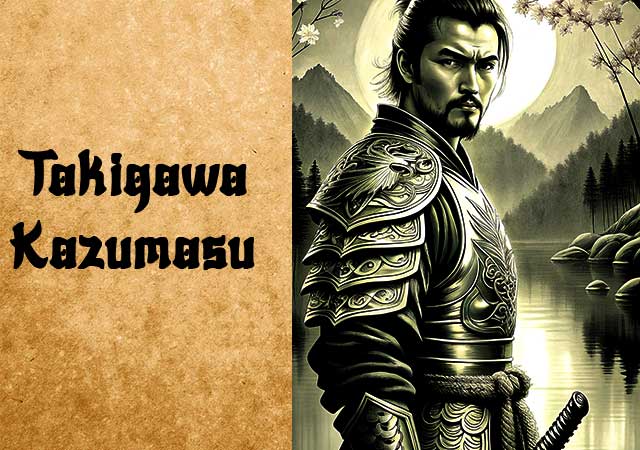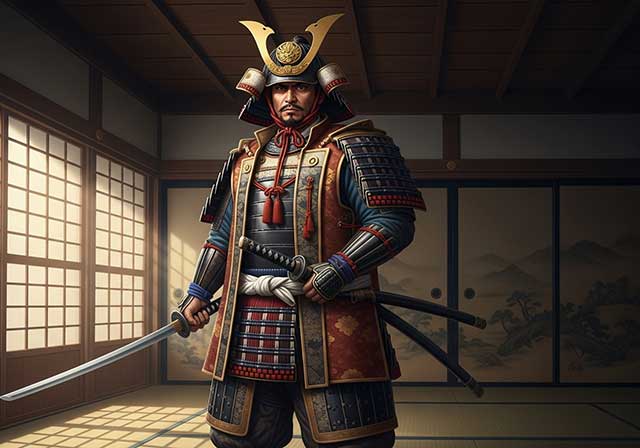
Takigawa Kazumasu (1525 – October 21, 1586), also known as Takikawa Sakon or Sakonshogen, was a prominent samurai and daimyō of the Sengoku period. He served as a loyal retainer and military commander under Oda Nobunaga and later Toyotomi Hideyoshi. His biological son, Toshimasu, was adopted by Maeda Toshihisa, the elder brother of Maeda Toshiie, and Kazumasu served alongside Toshiie in Nobunaga’s campaigns.
Early Life and Rise to Power
Kazumasu was born in 1525 in Ōmi Province as the son of Takigawa Kazumasa, lord of Kawachi-Takayasu Manor. The Takigawa clan traced its lineage to the Ki clan. He became one of Oda Nobunaga’s most trusted retainers, serving him from around 1558.
In 1561, he was sent as an envoy to Akagawa Motoyasu, a key general of the Mōri clan, as part of Nobunaga’s diplomatic efforts. Kazumasu played a crucial role in Nobunaga’s early military campaigns, leading the vanguard in the invasions of Ise Province in 1567 and 1568, successfully subduing numerous local families. By 1569, he was granted land in Ise and later supported Oda Nobukatsu, heir to the Kitabatake clan.
Military Exploits Under Nobunaga
Kazumasu participated in several major battles, including the Siege of Nagashima (1571, 1573, 1574) against the Ikkō-ikki. In 1572, alongside Sakuma Nobumori, he was dispatched to reinforce Tokugawa Ieyasu against Takeda Shingen at the Battle of Mikatagahara.
As a key commander in Nobunaga’s campaigns, Kazumasu took part in the Siege of Ichijōdani Castle (1573), the Battle of Nagashino (1575) (where he led infantry units), the Battle of Tennōji (1576), and the Battle of Tedorigawa (1577). He also led an invasion of Kii Province.
At the Second Battle of Kizugawaguchi (1578), Kazumasu commanded a white warship alongside Kuki Yoshitaka’s six black ships in a naval clash against the Mōri fleet. Beyond military engagements, he contributed to domestic affairs, aiding in the construction of Azuchi Castle in 1578 and conducting land surveys in Yamato Province with Akechi Mitsuhide in 1580.
Between 1579 and 1581, he fought in the Tenshō Iga War, capturing Seki Castle. In 1582, he led a campaign against the remnants of the Takeda clan alongside Kawajiri Hidetaka. Later that year, Nobunaga appointed him Kantō Kanrei (Deputy Shogun of the East), entrusting him with a portion of Kōzuke Province to monitor the powerful Hōjō clan.
Later Years and Decline
Following Nobunaga’s assassination in the Honnō-ji Incident (1582), Kazumasu attempted to defend Oda territories but suffered defeat against the Hōjō at the Battle of Kanagawa (1582), forcing his retreat to Ise Province.
In 1583, he initially sided with Shibata Katsuie and other Oda retainers against Toyotomi Hideyoshi. However, he was defeated while defending Kameyama Castle (Mie) after Hideyoshi used mines to breach its walls. Eventually, Kazumasu submitted to Hideyoshi and assisted in the Komaki Campaign (1584), attacking Kanie Castle alongside Kuki Yoshitaka.
However, his reputation suffered when he killed his own cousin, Maeda Tanetoshi, during the campaign. Ashamed of his failure, he shaved his head, became a Buddhist monk, and retired from military life. He is believed to have died in Echizen Province in 1586.
Kazumasu’s personal standard was marked by three vertically arranged red circles, symbolizing his identity on the battlefield. Despite his later decline, he remains a notable figure in the turbulent history of Japan’s Sengoku era.
See also
-
Sakakibara Yasumasa

Yasumasa was the second son of Sakakibara Nagamasa and was born in Ueno in Mikawa Province. From a young age, he began serving Tokugawa Ieyasu and eventually rose to the position of one of his most trusted generals. His wife was the daughter of Osuga Yasutaka. Ieyasu first noticed the young Yasumasa during the suppression of the Ikkō-ikki uprising in Mikawa in 1564. Thanks to his demonstrated abilities, Yasumasa was granted the privilege of using the character “yasu”—the second character of Ieyasu’s own name—in his own. Although he was the second child in his family, he became his father’s heir, though the exact reasons for this remain unknown.
-
Sakai Tadatsugu

Tadatsugu was one of the most renowned generals serving Tokugawa Ieyasu. After Ieyasu broke ties with the Imagawa clan, Tadatsugu—an ardent supporter of this decision—was granted command of Yoshida Castle in 1565, which controlled the coastal road from Tōtomi to Mikawa. During the Battle of Mikatagahara in 1573, he held the right flank of the Tokugawa forces even when the troops sent by Oda fled under the assault of the Takeda army. In the Battle of Nagashino in 1575, he personally requested permission to carry out a night attack on the Takeda camp, which he executed brilliantly together with Kanamori Nagachika.
-
Ryuzoji Takanobu

Takanobu was the eldest son of Ryūzōji Takaie and the great-grandson of Ryūzōji Iekane. His father was killed by a man named Baba Yoritiku in 1544. At a young age, Takanobu took Buddhist vows and received the monastic name Engetsu. However, around the age of eighteen, he returned to secular life, and in 1548, after the death of Ryūzōji Tanehide, he became the head of both branches of the Ryūzōji family.
-
Ouchi Yoshihiro

Ōuchi Yoshihiro was the second son of Ōuchi Hiroyo, who headed the Ōuchi clan in the western part of Honshu. In 1363, Shogun Ashikaga Yoshimitsu confirmed the Ōuchi family in the position of shugo of Suō and Nagato Provinces. In his youth, Yoshihiro assisted his father in strengthening the influence of the Northern Court on the island of Kyushu — they served under Imagawa Ryōsun, who had been tasked with subjugating the nine provinces of Kyushu.
-
Ouchi Yoshioki

Ouchi Yoshioki, the ruler of the provinces of Suo, Nagato, and Iwami, was one of the most capable military commanders and politicians of the late 15th and early 16th centuries. The son of Ouchi Masahiro, he governed from his residence in Yamaguchi in the province of Suo. In 1499, Yoshioki gave refuge to Shogun Ashikaga Yoshitane, who had been driven out of Kyoto by Hosokawa Masamoto. Shogun Yoshizumi, Masamoto’s protégé, ordered the lords of Kyushu to unite their forces against Yoshioki; however, they did not dare to do so, fearing the power of a man who by that time controlled six provinces. Having gathered a substantial army, Yoshioki marched from his native Suo toward Kyoto in order to restore Shogun Yoshitane to power.
-
Otomo Sorin

Ōtomo Yoshishige came from a noble lineage, being the eldest son of Ōtomo Yoshiaki, the ruler of Funai Province. The roots of the Ōtomo family traced back to Fujiwara Hidesato, the adopted son of Nakahara Chikayoshi. Fujiwara served Minamoto Yoritomo during the Genpei War and took part in battles in Mutsu Province in 1189. In 1193, he was appointed shugo of Buzen and Bungo Provinces, after which he adopted a new surname—Ōtomo.
-
Okudaira Sadamasa

Sadamasa was the son of Okudaira Sadayoshi and took part in several battles under Tokugawa Ieyasu, distinguishing himself in the Battle of Anegawa in 1570, where he took two heads. Around 1572 he was forced to enter the service of the Takeda clan, but after the death of Takeda Shingen in 1573 he returned to Tokugawa, leaving Tsukude Castle together with his men. As a result of this defection, Takeda Katsuyori ordered the execution of Sadamasa’s wife and brother, who were being held as hostages.
-
Okubo Tadatika

Tadatika, the son of Okubo Tadayō, entered the service of Tokugawa Ieyasu at the age of eleven, and took his first head in battle when he was sixteen. After the establishment of the Tokugawa shogunate, he was appointed as a rōjū — a senior bakufu official — and was regarded as one of Ieyasu’s most trusted advisors, alongside Honda Masanobu. He is also known for his military chronicle Mikawa Monogatari, which describes Ieyasu’s rise to power and the early years of the Tokugawa shogunate.

